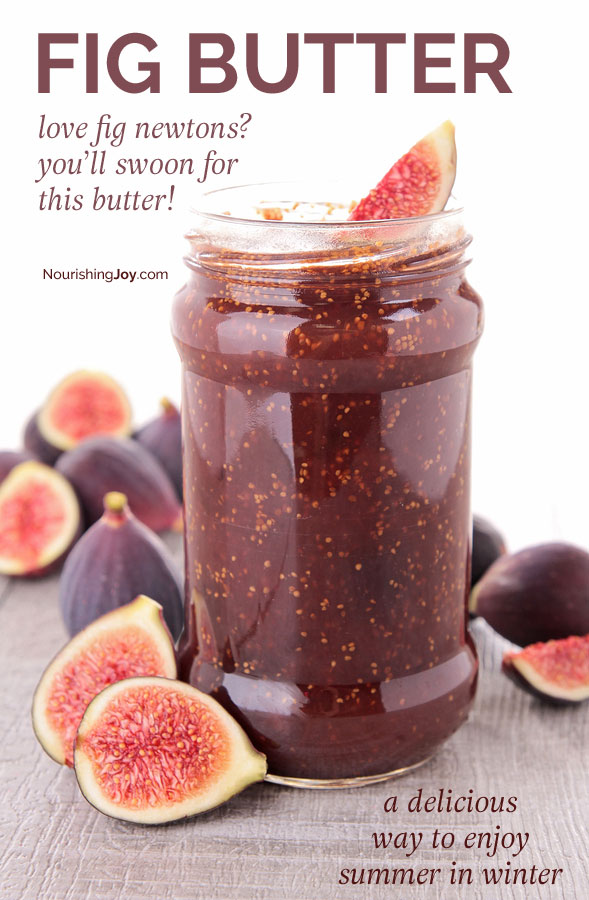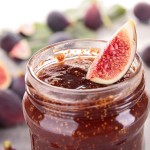Probiotic Fig Newton Butter
This post may contain affiliate links, including those from Amazon.com, which means we earn a small commission off your purchases. And here's the thing: We only mention services and products that we think are truly worth your attention, whether they're free, paid, or otherwise. This site relies on YOUR trust, so if we don't stand behind a product 110%, it's not mentioned. Period.
I love the winter.
I love the coziness of curling up by a fire after a long day of working or playing in the cold.
I love seeing candle-lined windows and houses lined with white Christmas lights bring a contemplative cheer to the long, dark nights.
I love Christmas and the celebratory sense of the holidays.
But come about mid-January, when the holidays are over and the snow or rain is no longer the novelty it was at Thanksgiving, that's when I pull dried figs out of their hiding place in the cupboard and I am reminded of summer. Those sun-drenched days that produced more abundant fruit than we knew what to do with and when we lingered long into the evening without worrying about coats and boots and hats.
Fruit Butters: A Quick, Delicious Way to Preserve the Harvest
This fig butter is one of my favorite ways to preserve the summer's abundance. I often slog through August and September when fruit and vegetables are at peak harvest – I often can't keep up with preserving it all.
But I find that this fig butter is a great “cheater” version. All I have to do is dehydrate the figs when they're ripe, then when I need a reminder of summer, just pull out the figs and whip up this fig butter then. It's quick, it's easy, and it's delicious (and it's seasonal eating at its best).
I also love this fig butter because it's a super-easy and super-excellent way to add more probiotic goodness into your diet – or that of your child – if you choose to add the simple fermentation step. Eating fermented and cultured foods regularly is an essential part of vibrant health, so foods like this lacto-fermented fruit butter pack a needed punch.
And here's the secret: Because this fruit butter starts with dehydrated fruit rather than fresh fruit and since dehydrating concentrates the sugars, so we don't need to add any other sweetener unless desired. (Yes!)
Feel free to substitute other dried fruits as well – fig and apple just happens to be a favorite of mine. Try Cinnamon Raisin by substituting raisins for the figs, then spread the finished butter on sourdough toast for a quick and dirty version of cinnamon swirl toast. Or try Peach Butter using dried peaches and lemon zest. The options are endless!
If you don't have access to fresh figs, you are certainly welcome to use store-bought dried figs. Otherwise, click here to learn how to dehydrate fresh figs.
And by the way, I call this “Fig Newton Butter” because I actually created it to be the filler for homemade fig newtons, but most of the time I don't mess with the newton cookie dough, which is a bit finicky – I just make the filling, which is quick. Spread it on toast or use it in a sandwich for your child's lunch and you're golden.
Fig Newton Butter
Ingredients
- ¾ cup dried figs
- ¼ cup dried apples
- 1 ½ - 2 cups warm filtered water
- zest of 1 small orange
- ½ teaspoon unrefined sea salt
- 2 tablespoons fresh whey
- 1-2 tablespoons raw honey, to taste
- ½ teaspoon cinnamon
Instructions
- Lacto-Fermented Version
- Coarsely chop the figs and apples and place in a bowl. Cover with warm filtered water and let sit for 20-25 minutes until softened. Drain well, reserving the soaking water.
- Place the softened fruit in a food processor with the orange zest, salt, and the whey. Process until a smooth paste forms, adding a teaspoon or so of the reserved water if necessary.
- Spoon the paste into a pint-sized mason jar, pushing down to eliminate any air holes and leaving at least 1 inch of headspace. Cover with at least 1/2-inch of the reserved soaking liquid and cover tightly.
- Set aside at room temperature for 1-2 days, then stir in honey and cinnamon, if desired, before storing in the refrigerator for 6-8 weeks.
- Quick Version
- Coarsely chop the figs and apples and place in a bowl. Cover with warm filtered water and let sit for 20-25 minutes until softened. Drain well, reserving the soaking water.
- Place the softened fruit in a food processor with the orange zest, salt, honey, and cinnamon. Process until a smooth paste forms, adding a teaspoon or so of the reserved water if necessary.
- Spoon into a glass storage jar and store in the refrigerator for 2-4 weeks.







can you do this with fresh figs and apples?
You can absolutely make delicious fig butter from fresh figs, but not with this recipe, as all the measurements are based on the fact that you start with dehydrated figs. A bunch of recipes come up when you google “fig butter,” but this one looks particularly promising (caveat: I haven’t tried it!) – http://cookingwithmaryandfriends.blogspot.ca/2013/09/fig-butter.html
Good luck and have fun!
My store bought dried figs now have a brown coating on them. What is it and can I still use them..s
By “coating” I assume you’re referring to a light powdery dusting, not a fuzzy covering of some kind. If it’s somewhat powdery, it’s normal, as that’s a normal crystallization that happens with dried figs, especially with extra-sweet varieties, and it’s totally edible.
So, yes, go ahead with the recipe as normal. No worries! 🙂
What is whey,and where do I get it.,can’t wait to try this
Whey is the liquid that gathers in yogurt as it sits. To obtain a bit, you can either just spoon out the puddle that forms in your yogurt the next time you scoop out a bit or spoon yogurt into a cheesecloth and hang it for 20-30 minutes over a bowl to collect the whey that drips off.
Have fun!
Is two days really enough fermentation time to create wonderful probiotics? Can it be left to ferment longer, or will that cause a deterioration? Since you are adding the whey, I’m assuming that allows for the short ferment time?
That’s a great question.
The reason it sits for only two days is because it’s a fruit-based ferment rather than a vegetable-based ferment, which means that if you leave it longer than two days, you run the risk of having it start to taste alcoholic as the fruit ferments. You’re certainly welcome to try it, but yes, there’s plenty of lovely probiotics in there within a two-day time, especially if you add whey and give it that kick-start, as all that fruit gives the bacteria lots of food to eat, which makes for very happy, productive bacteria. 🙂
Happy eating!
Hi. Thnaks for the fig butter recipe. Can the same recipe be made solely with dried figs if no dried apples are on hand? If so, what quantity of dried figs? Would the rest of the recipe & instructions remain the same, or would certain adjustments need to be made if only dried figs are used? Also, is there a way of making the butter without the fruit having to ferment? If so, how? Thanks again.
Yes and yes! 🙂
You may substitute the same amount of dried figs for the dried apples.
And just skip the fermenting step if you don’t want to ferment it. No other adjustments need to be made.
I hope that helps! 🙂
You mention in the article about the simple fermentation step. Is that step in the above recipe already? I am very interested in fermented foods and I am dehydrating my fresh figs as we speak!! Can’t wait to try this fig butter.
Yes, the fermentation step is the last one when you let it sit out before refrigerating it. It is optional, but it’s a great way to boost the probiotics!
I hope that helps!
Hello, does the fig butter need to be airtight sealed when on the bench for 2 days? Thank you
No, in fact it’s better if the lid is a bit loose or you just cover it with a tea towel (or some such thing).
when making fig butter, is it ok to substitute edible young living orange oil instead of orange zest?
Well, yes and no. No because no matter WHAT any essential oil company says, ingesting essential oils should be done with extreme caution because putting such potent medicines (even when they’re edible) in our bodies affects different people different ways.
That said, orange oil is one of the least “dangerous” oils and less potent versions are often used culinarily, so if you only use a drop or two in the entire batch, I wouldn’t worry about it too much.
However, I cannot overstate that ingesting essential oils should not be done lightly, even when used as a culinary, rather than medicinal, ingredient. Oils are potent!
Hello I’m currently thinking of making this but i don’t have access to dried apples. Is there a way i can make this work and leave it tasting awesome? Maybe use dates or just more figs? Are dates possible? Also last question, I don’t consume dairy products but I think that the whey is not obligatory is it? I was looking about the use of whey in fermenting and read that it wasn’t necessary so I think I can skip that step the only thing that would change is maybe the number of days it takes to ferment?
Yes, you are correct on all fronts. If you don’t have access to dried apples, yes, you may certainly make it with just dried figs. And as for the whey, that step is completely optional – it’s merely the step that makes it “probiotic,” as the title promises. However, if you make the recipe up to that point, you’ll still end up with a scrumptious fig butter – it just won’t be fermented and you can use it immediately.
I hope that helps!
I can’t wait to try this recipe. Also love the name of your blog,
Thank you! I hope you enjoy the fig butter. 🙂
Would like to have nutrition for this! My diet is very strict!?
If the nutrition info is important to you, run the ingredients through your favorite nutrition site (such as http://nutritiondata.self.com) to find the information you’re looking for. We purposely do not provide nutrition info with our recipes, as they are so easily misunderstood and for MOST people (not you), they give an inaccurate picture of what may or may not be healthy for their diet.
I love fig butter! I cannot wait to make this at home – I don’t have to buy it from the store anymore! Thank you so much for sharing this recipe. Can this be done with almost all fruits?
Yes, pretty much any dried fruit works, although some better than others. Have fun experimenting!
This recipe sounds delicious. Can it be frozen?
Yes, absolutely! 🙂
This sounds awesome, thank you!
I still have loads of dried apples from last year’s harvest and this year looks to be a bumper crop year so I’m glad to find a recipe to use some dried apples up!